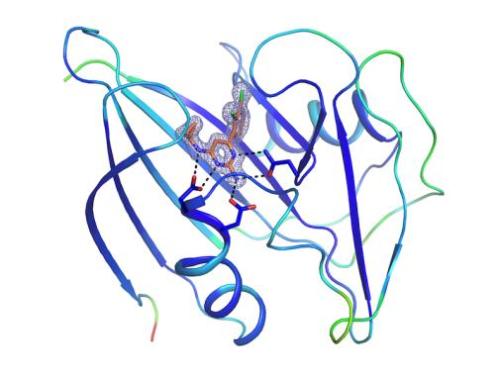A new concept for the treatment of cancer

Crystal structure of human MTH1 in complex with a key inhibitor.
Source: Stockholm University, Prof. Pal Stenmark.
A team of researchers from five Swedish universities has identified a new way to treat cancer. They present their concept in the journal „Nature“. It is based on inhibiting a specific enzyme called MTH1. Cancer cells, unlike normal cells, need MTH1 to survive. Without this enzyme, oxidized nucleotides are incorporated into DNA, resulting in lethal DNA double-strand breaks in the cancer cells. The research group at Stockholm University has determined the structure of MTH1 based on diffraction measurements at HZB´s MX-beamline at BESSY II. These detailed structural studies are important for the development of efficient inhibitors targeting MTH1.
In recent decades, the development of new anticancer agents focused on targeting specific genetic defects in cancer cells. These often are effective initially, but later cause trouble due to emerging rapid resistance. In the current study, the researchers present a general enzymatic activity that all cancers tested rely on and that seems to be independent of the genetic changes found in specific cancers. The research team shows that all the investigated cancer tumours need the MTH1 enzyme to survive. In this respect, cancer cells differ from normal cells, which do not need this enzyme.
“The concept is built on the fact that cancer cells have an altered metabolism, resulting in oxidation of nucleotide building blocks,” says Thomas Helleday, professor at Karolinska Institutet, who leads the study: "MTH1 repairs the oxidized building blocks, preventing the oxidative stress from being incorporated into DNA and becoming DNA damage. This allows replication in cancer cells so they can divide and multiply. With an MTH1 inhibitor, the enzyme is blocked and damaged nucleotides enter DNA, causing damage and killing cancer cells."
Normal cells do not need MTH1 as they have regulated metabolism preventing damage of nucleotide building blocks. Finding a general enzymatic activity required only for cancer cells to survive opens up a whole new way of treating cancer.
Original publication:
“MTH1 inhibition kills cancer by preventing sanitation of the dNTP pool”, Helge Gad, Tobias Koolmeister, Ann-Sofie Jemth et al., Nature, online 2 April 2014, doi: 10.1038/nature13181. http://dx.doi.org/10.1038/nature13181.
“Stereospecific targeting of MTH1 by (S)-crizotinib as anticancer strategy”, Kilian V. M. Huber, Eidarus Salah, Branka Radic et al., Nature, online 2 April 2014, doi: 10.1038/nature13194. http://dx.doi.org/10.1038/nature13194
https://www.helmholtz-berlin.de/pubbin/news_seite?nid=13961;sprache=en
- Copy link
-
The future of corals – what X-rays can tell us
This summer, it was all over the media. Driven by the climate crisis, the oceans have now also passed a critical point, the absorption of CO
2 is making the oceans increasingly acidic. The shells of certain sea snails are already showing the first signs of damage. But also the skeleton structures of coral reefs are deteriorating in more acidic conditions. This is especially concerning given that corals are already suffering from marine heatwaves and pollution, which are leading to bleaching and finally to the death of entire reefs worldwide. But how exactly does ocean acidification affect reef structures?
Prof. Dr. Tali Mass, a marine biologist from the University of Haifa, Israel, is an expert on stony corals. Together with Prof. Dr. Paul Zaslansky, X-ray imaging expert from Charité Berlin, she investigated at BESSY II the skeleton formation in baby corals, raised under different pH conditions. Antonia Rötger spoke online with the two experts about the results of their recent study and the future of coral reefs.
-
Energy of charge carrier pairs in cuprate compounds
High-temperature superconductivity is still not fully understood. Now, an international research team at BESSY II has measured the energy of charge carrier pairs in undoped La₂CuO₄. Their findings revealed that the interaction energies within the potentially superconducting copper oxide layers are significantly lower than those in the insulating lanthanum oxide layers. These results contribute to a better understanding of high-temperature superconductivity and could also be relevant for research into other functional materials.
-
Electrocatalysis with dual functionality – an overview
Hybrid electrocatalysts can produce green hydrogen, for example, and valuable organic compounds simultaneously. This promises economically viable applications. However, the complex catalytic reactions involved in producing organic compounds are not yet fully understood. Modern X-ray methods at synchrotron sources such as BESSY II, enable catalyst materials and the reactions occurring on their surfaces to be analysed in real time, in situ and under real operating conditions. This provides insights that can be used for targeted optimisation. A team has now published an overview of the current state of knowledge in Nature Reviews Chemistry.
